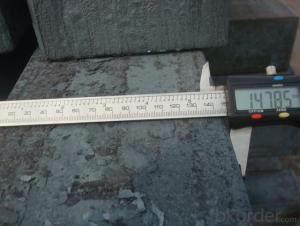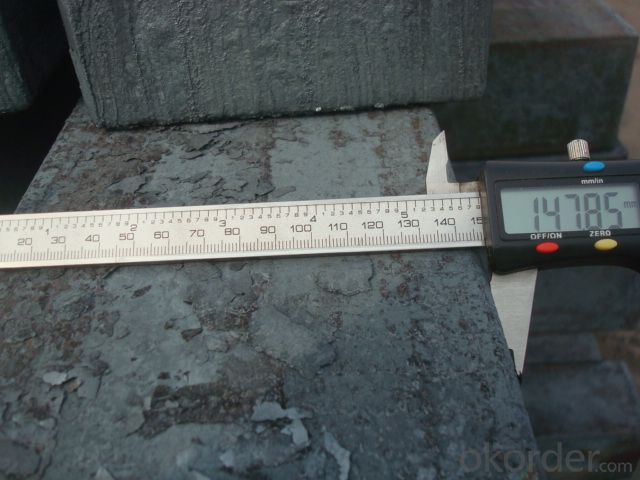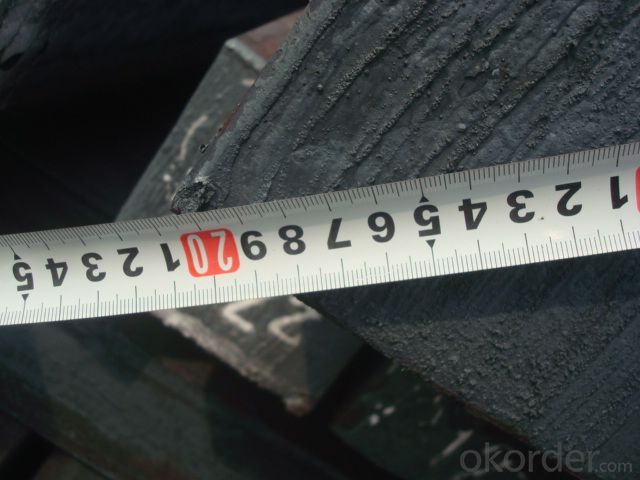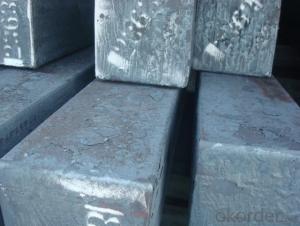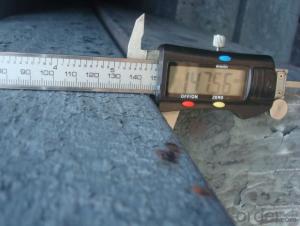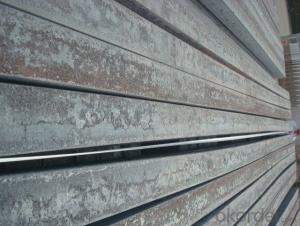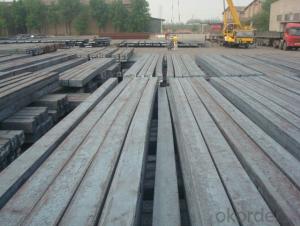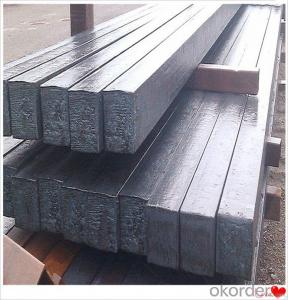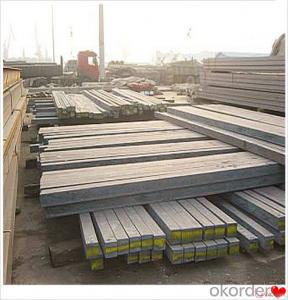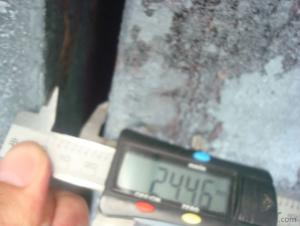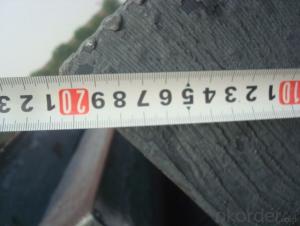Steel Bloom/Billet Manufactured by Blast Furnace by Continue Casting Making
- Loading Port:
- Tianjin
- Payment Terms:
- TT OR LC
- Min Order Qty:
- 1000 m.t.
- Supply Capability:
- 10000 m.t./month
OKorder Service Pledge
OKorder Financial Service
You Might Also Like
Steel Bloom/Billet Manufactured by Blast Furnace by Continue Casting Making
1.Structure of Steel Bloom/Billet Manufactured by Blast Furnace by Continue Casting Making
Steel Billets Manufactured by Continue Casting is the raw material of all kinds of steel mill. Billet section of square, round, flat, rectangular and abnormity, etc Several, mainly related to shape of rolled products. Simple rolled section steel, choose cross section of square billet or rectangular billet. rolling The sector products such as flat steel, Angle steel, select the rectangular billet or slab. Had better profiled billet when production beams, channels, and in rolling process Lines and improve the yield. The raw material of round billet is the production of seamless tube.
2.Main Features of Steel Bloom/Billet Manufactured by Blast Furnace by Continue Casting Making.
.
There are three shapes of the steel billets: square billet, slab, rectangular billet The Chinese billet, rectangular billet is mainly suitable for rolling hot rolled strip, building reinforced bar, Ordinary wire, high speed wire rod and various small profile. Of the slab are mainly used for rolling plate and hot coil sheet.
3. Steel Bloom/Billet Manufactured by Blast Furnace by Continue Casting Making Images

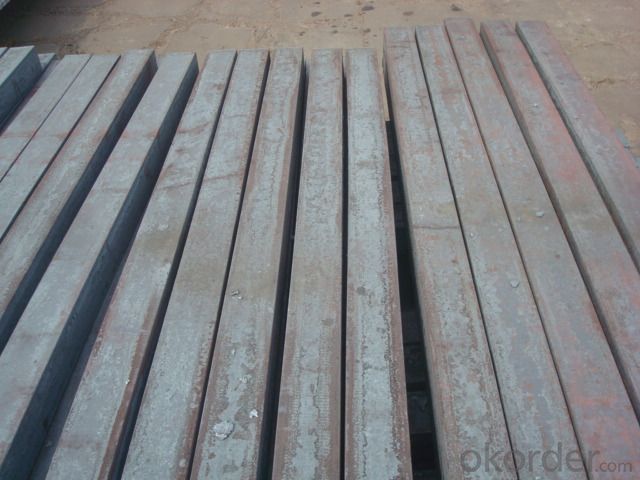
4. Steel Bloom/Billet Manufactured by Blast Furnace by Continue Casting MakingSpecification
Material standard The editor Range of thickness: 150-240 - mm + / - 5 mm width range: 880-1530 - mm + / - 20 mm Length: 3700-10000 - mm + / - 500 - mm Cross-sectional size: 64 * 64; 82 * 82; 98 * 98; 124 * 124; 120 * 150; 152 * 164; 152 * 170 mm Length: 9000 mm Section of tolerance: billet: 1.0 + / - 2.0-1.0 + / - 1.0 mm slab: width: + / - 2.0 mm thickness: + / - 3.0 mm The length tolerance: + / - 200 mm Section diagonal tolerance: 3.5-8.0 MM Billet section size protrusions requirements: < 1242 mm, do not allow; > = 1242 mm, < = 2 mm 1242 mm, < = 3 mm Beheading (shear) extension deformation: < 1242 mm billet: no control; The slab: < = 15 mm Surface tilt: no more than billet section 0.1 Bending: every 1 m length is not more than 10 mm The distortion: length < = 5 m, < = 11. ; The length of the < = 7.5 M, < = 5. Material % 3 sp/PS chemical composition: C Mn Si S P
5.FAQ of Steel Bloom/Billet Manufactured by Blast Furnace by Continue Casting Making
We have organized several common questions for our clients,may help you sincerely:
①How about your company?
A world class manufacturer & supplier of castings forging in carbon steel and alloy steel,is one of the large-scale professional investment casting production bases in China,consisting of both casting foundry forging and machining factory. Annually more than 8000 tons Precision casting and forging parts are exported to markets in Europe,America and Japan. OEM casting and forging service available according to customer’s requirements.
②Inclusions in the continuous casting billet come from? Found in the continuous casting billet of inclusion complex, forms.Judging from the inclusion of ingredients, can be roughly know the source of inclusions. (1) the weak deoxidizing elements contained in the inclusion is more, and SiO2 + MnO content greater than 60%, the size is more than 50 microns, which can determine the inclusions are caused by air and molten steel secondary oxidation; (2) inclusion composition and refractory materials, with special shape, size is larger, can determine for refractory erosion;(3) inclusion contains such elements as potassium, sodium, is due to mould protection slag in molten steel.
③What is the advantage of the continue Casting steel billet comparing to the die casting steel billet?
Compared with die casting, continuous casting has the advantages of: 1. To simplify the Steel billet The production process 2. Improve the metal yield 3. Improve the quality of the billet 4. Reduces the steel worker's labor intensity 5. Save energy and reduce consumption
Steel billet is produced by the method of through three processes: It is through the steelmaking system of continuous casting equipment, directly by the molten steel pouring into billet; The second is the steelmaking system in the production of steel ingot casting billet through system of steel rolling rolling equipment or processing of steel semi-finished products; Three is the steelmaking system production of steel ingot by forging the semi-finished product processing equipment.
- Q: What are the main factors affecting the tensile strength of steel billets?
- The main factors affecting the tensile strength of steel billets include the chemical composition of the steel, the heat treatment process, the presence of impurities or defects in the material, the grain size and orientation, and the processing conditions used during manufacturing.
- Q: How are steel billets used in the production of industrial boilers?
- Steel billets are an essential component in the production of industrial boilers. These billets, which are typically made of high-quality steel, serve as the raw material for fabricating the various parts and components of a boiler. The manufacturing process starts with the steel billets being heated to a specific temperature, which allows them to be easily shaped and formed. They are then passed through a series of rolling mills, where they are transformed into different shapes and sizes, such as plates, bars, or tubes, depending on the specific requirements of the boiler design. These billets are then further processed to create the necessary boiler components. For example, plates are cut and shaped to form the boiler shell, which serves as the main structure of the boiler. Bars are used to create the boiler tubes, which are responsible for transferring heat from the combustion chamber to the water. Additionally, other parts such as flanges, fittings, and supports are also made from steel billets. The quality and strength of the steel billets used in the production of industrial boilers are crucial factors in ensuring the durability and efficiency of the final product. Steel billets with high tensile strength and excellent heat resistance properties are preferred, as they can withstand the high pressures and temperatures associated with boiler operations. In summary, steel billets play a critical role in the production of industrial boilers by providing the raw material necessary for fabricating the various components. Their versatility, strength, and durability make them an ideal choice for creating the robust and reliable boilers required for a wide range of industrial applications.
- Q: What are the potential applications of steel billets in the medical aftermarket?
- The medical aftermarket offers a wide range of potential applications for steel billets. One important application is the manufacture of surgical instruments, such as scalpels, forceps, scissors, and orthopedic implants. Steel billets are capable of producing high-quality and durable surgical instruments due to the strength and corrosion resistance of steel. Furthermore, steel billets are also useful in the production of medical equipment and devices. For instance, they can be used to create components for X-ray machines, CT scanners, and MRI machines. The excellent conductivity and high strength-to-weight ratio of steel make it a suitable choice for these demanding applications. In addition, steel billets can be utilized in the manufacturing of medical furniture and fixtures. Steel is commonly employed in the construction of hospital beds, examination tables, and cabinets due to its durability and ease of maintenance. Steel billets can provide the necessary raw material for the production of these essential medical items. Moreover, steel billets can also be employed in the fabrication of prosthetics and orthotics. These devices often require materials that are both strong and lightweight to ensure proper functionality and comfort for patients. Steel billets can be processed into various shapes and sizes to create prosthetic limbs, braces, and other orthopedic devices. In summary, the diverse and crucial potential applications of steel billets in the medical aftermarket cannot be underestimated. From surgical instruments to medical equipment, furniture, and prosthetics, steel billets possess the necessary qualities of strength, durability, and corrosion resistance to meet the demanding requirements of the medical industry.
- Q: What are the potential applications of steel billets in the packaging industry?
- Steel billets have a wide range of potential applications within the packaging industry. One of the primary uses of steel billets is in the production of steel drums and barrels, which are widely used for packaging and transporting various materials such as chemicals, oils, and liquids. Steel billets can also be utilized in the manufacturing of steel cans, which are commonly used for packaging food and beverages. Steel cans offer excellent durability and strength, ensuring that the contents are well protected during transportation and storage. Additionally, steel cans provide an airtight seal, helping to preserve the freshness and quality of the packaged products. Furthermore, steel billets can be utilized in the production of steel strapping and bands, which are used for securing and bundling packaged goods. Steel strapping offers superior strength and resistance against breakage, making it an ideal choice for heavy-duty packaging requirements. Another potential application of steel billets in the packaging industry is in the production of wire mesh containers and pallets. These containers and pallets are commonly used for storing and transporting goods in warehouses and distribution centers. Steel billets provide the necessary strength and durability to withstand the weight and handling of various packaged materials. Moreover, steel billets can also be used in the production of steel tubes and pipes, which are utilized in the manufacturing of packaging machinery and equipment. These tubes and pipes serve as structural components in packaging machines, providing stability and strength to ensure proper functioning and longevity. Overall, the potential applications of steel billets in the packaging industry are vast and varied. From steel drums and cans to strapping and containers, steel billets offer the necessary strength, durability, and reliability required for packaging and transporting various products effectively.
- Q: Are steel billets used in the production of sporting goods?
- Yes, steel billets are commonly used in the production of sporting goods. They are often utilized to create various components such as the shafts of golf clubs or the frames of bicycles. Steel billets provide durability and strength to these sporting goods, making them suitable for intense physical activity.
- Q: What are the different surface treatments for improved weldability in steel billets?
- There are several surface treatments that can be used to improve weldability in steel billets. These include processes such as pickling, grinding, and shot blasting. Pickling involves removing any surface impurities or oxides through the use of acid solutions. Grinding helps to smooth out any rough or uneven surfaces, ensuring better contact and fusion during the welding process. Shot blasting uses high-speed projectiles to clean the surface and create a rough texture, which enhances the adhesion of the weld. These treatments help to remove contaminants and improve the overall quality and weldability of the steel billets.
- Q: How are steel billets used in the manufacturing of aerospace components?
- Steel billets serve as a crucial raw material in the production of aerospace components. These semi-finished steel products, shaped like squares or rectangular solids, undergo a series of processes to become the required parts. To begin with, the steel billets go through a heating process called "hot working." This involves subjecting the billets to high temperatures, typically around 1200-1300°C, to increase their malleability and facilitate shaping. The heated billets are then passed through rolling mills, where they gradually decrease in size and take on the desired forms, such as bars, rods, or sheets. Once the steel billets have been shaped accordingly, they undergo further processing techniques like forging, extrusion, or machining to create specific aerospace components. For instance, the billets can be forged or machined to manufacture critical parts like engine shafts, landing gear components, or structural supports. The utilization of steel billets in aerospace manufacturing presents several advantages. Steel is renowned for its high strength, durability, and excellent mechanical properties, making it an ideal material for aerospace applications. Steel components can endure extreme conditions, such as high temperatures and pressures, while resisting corrosion and fatigue, thereby ensuring the safety and reliability of aerospace systems. Furthermore, steel billets can be customized to meet the stringent requirements of aerospace components. By carefully controlling the composition, heat treatment, and manufacturing processes, steel billets can be tailored to exhibit specific properties, such as a high strength-to-weight ratio, exceptional heat resistance, or enhanced fatigue life. This customization guarantees that the resulting aerospace components meet the industry's demanding standards. In conclusion, steel billets play a vital role in the production of aerospace components. Through a series of heating, shaping, and processing techniques, steel billets are transformed into various forms that are then further processed to create critical aerospace parts. The utilization of steel as a material offers exceptional strength, durability, and customization possibilities, thereby ensuring the production of high-quality and reliable aerospace components.
- Q: How are steel billets used in the production of automotive steering systems?
- Steel billets are used in the production of automotive steering systems as they serve as the raw material for forging steering components such as the steering arm, tie rod ends, and steering knuckles. These billets are heated and shaped through forging processes to create strong and durable steering components that ensure the reliable performance and safety of the steering system in vehicles.
- Q: What is the melting point of steel billets?
- The melting point of steel billets can vary depending on the type of steel being used. Generally, the melting point of steel ranges from 1370 to 1530 degrees Celsius (2500 to 2800 degrees Fahrenheit). However, it is important to note that different grades and compositions of steel can have slightly different melting points. Additionally, the melting point can also be influenced by other factors such as impurities, alloying elements, and the presence of other metals in the steel. Therefore, it is always recommended to refer to the specific material specifications or consult with metallurgical experts for precise information on the melting point of steel billets.
- Q: Can steel billets be used for making tools?
- Indeed, tools can be made using steel billets. Steel billets, which are typically hot-rolled into bars, rods, or other forms, serve as semi-finished products. These billets possess exceptional strength, durability, and resistance to wear and tear, rendering them suitable for tool manufacturing. Tools necessitate materials capable of withstanding high pressures, cutting forces, and repetitive usage, and steel billets possess the necessary qualities to fulfill these requirements. Furthermore, steel billets can undergo additional processes such as machining, forging, or heat treatment to enhance their properties, enabling the production of various tool types including wrenches, hammers, chisels, and more.
Send your message to us
Steel Bloom/Billet Manufactured by Blast Furnace by Continue Casting Making
- Loading Port:
- Tianjin
- Payment Terms:
- TT OR LC
- Min Order Qty:
- 1000 m.t.
- Supply Capability:
- 10000 m.t./month
OKorder Service Pledge
OKorder Financial Service
Similar products
Hot products
Hot Searches
Related keywords
